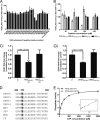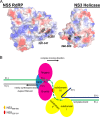The C-terminal 50 amino acid residues of dengue NS3 protein are important for NS3-NS5 interaction and viral replication
- PMID: 25488659
- PMCID: PMC4303688
- DOI: 10.1074/jbc.M114.607341
The C-terminal 50 amino acid residues of dengue NS3 protein are important for NS3-NS5 interaction and viral replication
Abstract
Dengue virus multifunctional proteins NS3 protease/helicase and NS5 methyltransferase/RNA-dependent RNA polymerase form part of the viral replication complex and are involved in viral RNA genome synthesis, methylation of the 5'-cap of viral genome, and polyprotein processing among other activities. Previous studies have shown that NS5 residue Lys-330 is required for interaction between NS3 and NS5. Here, we show by competitive NS3-NS5 interaction ELISA that the NS3 peptide spanning residues 566-585 disrupts NS3-NS5 interaction but not the null-peptide bearing the N570A mutation. Small angle x-ray scattering study on NS3(172-618) helicase and covalently linked NS3(172-618)-NS5(320-341) reveals a rigid and compact formation of the latter, indicating that peptide NS5(320-341) engages in specific and discrete interaction with NS3. Significantly, NS3:Asn-570 to alanine mutation introduced into an infectious DENV2 cDNA clone did not yield detectable virus by plaque assay even though intracellular double-stranded RNA was detected by immunofluorescence. Detection of increased negative-strand RNA synthesis by real time RT-PCR for the NS3:N570A mutant suggests that NS3-NS5 interaction plays an important role in the balanced synthesis of positive- and negative-strand RNA for robust viral replication. Dengue virus infection has become a global concern, and the lack of safe vaccines or antiviral treatments urgently needs to be addressed. NS3 and NS5 are highly conserved among the four serotypes, and the protein sequence around the pinpointed amino acids from the NS3 and NS5 regions are also conserved. The identification of the functionally essential interaction between the two proteins by biochemical and reverse genetics methods paves the way for rational drug design efforts to inhibit viral RNA synthesis.
Keywords: Dengue Virus; Flavivirus; Nonstructural Protein Interaction; Plus-stranded RNA Virus; Protein-Protein Interaction; Replication Complex; Viral Helicase; Viral Polymerase; Viral Protein; Viral Replication.
© 2015 by The American Society for Biochemistry and Molecular Biology, Inc.
Figures







References
-
- Bhatt S., Gething P. W., Brady O. J., Messina J. P., Farlow A. W., Moyes C. L., Drake J. M., Brownstein J. S., Hoen A. G., Sankoh O., Myers M. F., George D. B., Jaenisch T., Wint G. R., Simmons C. P., Scott T. W., Farrar J. J., Hay S. I. (2013) The global distribution and burden of dengue. Nature 496, 504–507 - PMC - PubMed
-
- Lindenbach B. D., Thiel H., Rice C. M. (2007) in Fields Virology (Knipe D. M., Howley P. M., eds) 5th Ed., pp. 1101–1152, Wolters Kluwer/Lippincott Williams & Wilkins, Philadelphia
-
- Bartholomeusz A. I., Wright P. J. (1993) Synthesis of dengue virus RNA in vitro: initiation and the involvement of proteins NS3 and NS5. Arch. Virol. 128, 111–121 - PubMed
Publication types
MeSH terms
Substances
Associated data
- Actions
LinkOut - more resources
Full Text Sources
Research Materials
Miscellaneous

